The Miyakojima Triathlon: Where Competitors, Family Members, and Supporters All Face Off in Earnest
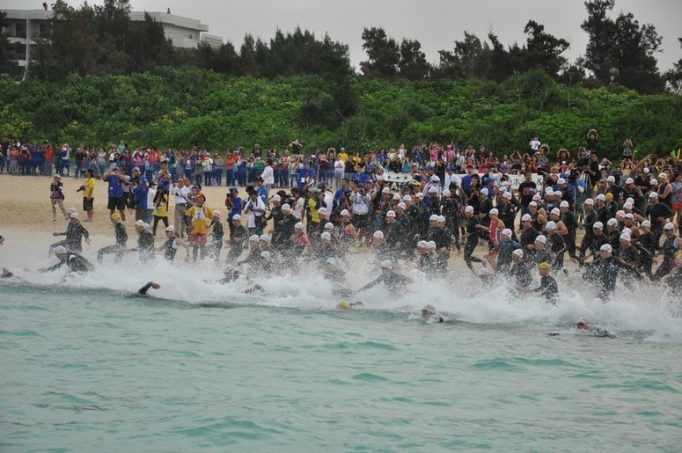
On April 17, 2016, we went to offer our support for the Miyakojima Triathlon–a 202.195 km-long endurance race combining 3 km of swimming, 157 of cycling, and 42.195 of running. The competition is one of the most popular long-distance triathlons in Japan, with a course that covers every part of Miyako Island and the neighboring remote islands connected by a bridge.
The triathletes were greeted by the beautiful blue seas around Miyako, its warm climate, and above all by the spirit of utuimuchi (hospitality) demonstrated toward them by islanders. These attractions unique to Miyako Island, along with a desire to earn the sobriquet of “Strongman” given to those who completed the race, drew 1,546 competitors from 16 countries and Japan’s 47 prefectures.
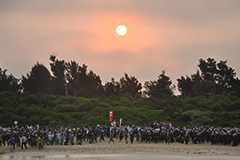
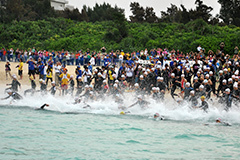
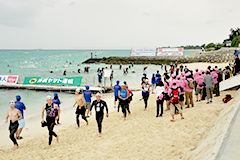





Founded 32 years ago, the Triathlon attracts interest from around the world. The first-aid and operational structures it has cultivated over those years are regarded as being among the best for any such event anywhere. The event’s slogan has likewise remained the same since the start: “Waidoh-waido,” a gentle parody of the expression “waido-wai” that in the local Miyako Island dialect means “go all out to do your best!” Even today, spectators both young and old can be heard urging on the competitors with shouts of “Waidoh-waido!” The cheer in a sense is meant both for the triathletes who devote their lives and livelihoods to competing in this endurance contest and their family members giving their wholehearted support from the sidelines. It also encompasses all of the sponsoring organization staff, volunteer helpers, and islanders who face up in earnest to the challenge by welcoming everyone with their work and their warm hospitality. Anyone attending the event can come face to face with this sincere linking of hearts and spirits in the settings around them.
The transition areas, where everyone’s morale lifts
When the triathletes finish their 3 km swim and come up on land, they head to the transition area where they are welcomed with hearty applause and words of encouragement. The site of the competitors changing their equipment and mental focus in a heavy rain in preparation for the 157 km bike ride as they pass through the several 100 m-long transition area with family members, friends, and comrades cheering them on, handing them towels and water, and offering pats on the back leaves a strong impression.
The tension rises as each stage of the event changes and the triathletes struggle with time limits. The transition area for the switch from cycling to running in particular sees the triathletes receive applause and cheers from event staff as well as their friends and family as they end the bike stage and steel themselves for taking on a full marathon. The cycling helmets come off, the running shoes go on, and then it’s time to meet the marathon challenge. The demonstrative zeal of the triathletes boosting themselves over and over again with each change of event and the morale boost that comes from the spirited support offered by those around them are the kinds of scenes found at a triathlon. At least the competitors need not be concerned about the equipment they need to take out for each stage of the event, as it is carried for them in advance to each three transition areas and the finish line using a color-coded baggage system that makes it hard for mistakes to occur.







The finish line a succession of emotions
A variety of dramas unfold across the circuit that leads up to a triathlete entering the stadium and breaking through the finish line tape. It is a harsh day, with a time limit of 13 hours, 30 minutes, and the competitors have built up to the day with the support of family and relatives, sweethearts and friends, colleagues, students, and others. They all wait for their respective triathletes’ returns, and raise their hands together with them at the finish line. Some triathletes reach the finish line with friends bearing banners and some are greeted with enormous bouquets. There have even been cases of triathletes proposing marriage to the sweetheart who happily greets them at the finish line.
It was plainly obvious that support and understanding from those around the athlete are indispensable when it comes to taking on the challenge of a triathlon. In a sense, the finish line is not just for the competitor but for his or her supporters, too. 。
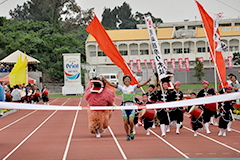

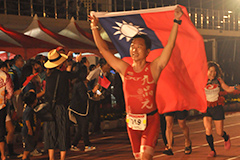
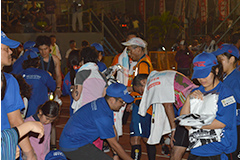
Interviews with triathletes from elsewhere in Japan and around the world
Two athletes have taken part in every single Miyakojima Triathlon since the event began. A unique feature of this event is that there are many athletes who take part year after year, or at least have done so on multiple occasions. Also, surprisingly 1,423 of the 1,546 participants come from outside of Okinawa, 116 of them came from overseas. We spoke with a few of the participating triathletes who came to Okinawa from elsewhere to hear what they had to say about the event.
Mr.Hiroyuki Yonekura
From Shiga Prefecture, Yonekura-san has participated in the Triathlon 24 times. He is a member of the “Big Lake” triathlon team and participated in the event again this year with many of his teammates. They participate in the Kaike Triathlon every year, and afterwards, the Miyakojima Triathlon. We asked Yonekura-san for his thoughts about this year’s event.
“I took the cycling portion at a slower-than-normal pace, but I was able to make up for on the running section. It was really windy this year, making things tough. The rain that fell after the swimming portion was heavy, and I needed to be careful when I ran so I didn’t fall over. Still, altogether, I enjoyed being able to finish my run. I can participate in the Triathlon only two more times, and I plan to do so and finish both times!”
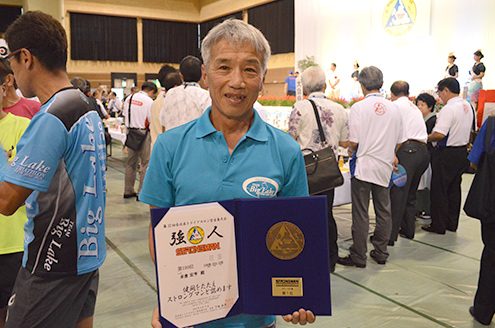
Ms.Hiroko Gouda
“I live in Miyagi Prefecture, and this year is the fifth in a row that I’ve competed in the Triathlon. It’s been 10 years since I first started in running in marathons. I like running. I run before and after work, and I run even when snow is falling. Aside from this event, I also take part in the one held in Sado.”
What’s special about this event? “The encouragement you get is wonderful. I love how friendly the islanders are. I also like the sense of accomplishment you get after crossing the finish line given how long the race is. I really enjoyed being able to finish the race in time again this year. I hope to take part in it again next year, too!”
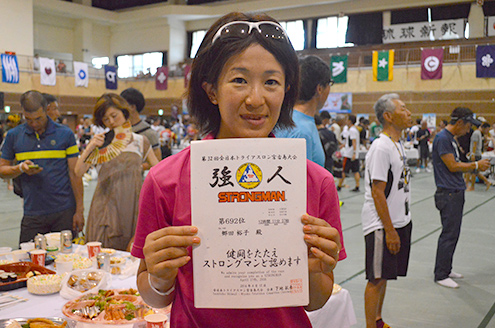
The DWD Triathlon team from Taiwan
The DWD team is a group of young men and women who participate in triathlons together. This year marks the first time they took part in the Miyakojima Triathlon.
Why did you decide to take part in this Triathlon? “We did research and saw that Japan’s four largest triathlons were the Goto, Sado, Kaike, and Miyakojima events. We’ve already completed the Goto and Kaike triathlons. We decided ‘Miyakojima is next!’ and came as a group. We completed this one, so next we take on the last one in Sado.”
“The Miyakojima Triathlon was a lot of fun for us on our first time. We may be a team but that doesn’t mean that everyone can always take part, so this was a good chance for everyone to meet and take part in an event together. Having everyone participate this time around was great.”
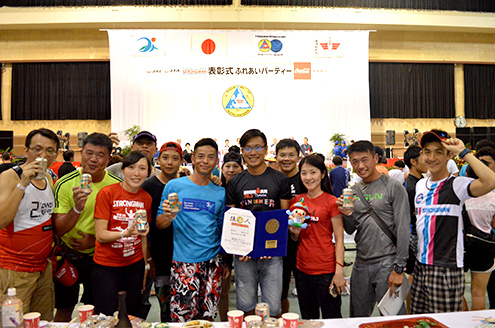
The “Waidou-waido” Spirit Is The Biggest Attraction
Sporting events held in Okinawa like the Naha Marathon are growing in popularity year by year, and feature many athletes from outside the prefecture and even country who are repeat participants. One of the attractions for these repeaters is the wonderful support they get from along the roadsides. That may be because the warm hospitality of such words of encouragement from the “Uchinanchu (Okinawan people)” as “Yuimahru (We’re working together)” and “Ichariba chohde (One we meet, we’re brothers and sisters)” resonate in the participants’ hearts.
The Miyakojima Triathlon is all the more appealing due to those elements unique to it. A man that took part in the Triathlon for the first time told me how grateful he was for the management that had measures in place to keep stress levels down, for the two parties that were held two days prior to and after the event, and for how little children offered wholehearted encouragement from the sidelines and even lent a hand as volunteers.
The athletes and their supporters took on the Miyakojima Triathlon challenge in earnest. And everyone on Miyako Island responded to those thoughts and efforts in earnest. The most attractive thing about this event is how it links hearts and spirits like this. The “Waidoh-waido” spirit that has carried on from the very start is truly at the root of this Triathlon.
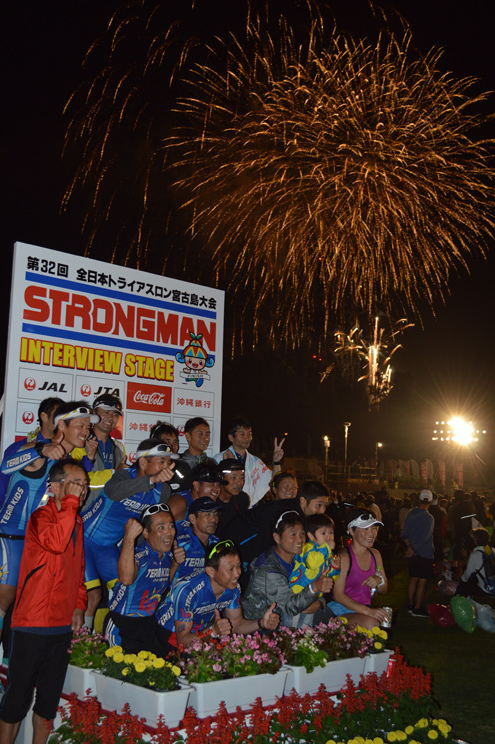
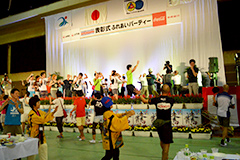
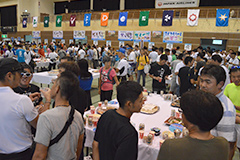
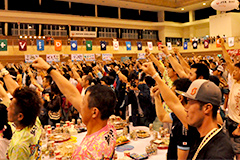
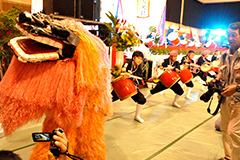
Triathletes raising their voices with shouts of “Ganbaru zo! (Let’s do it!)” and “Yeah!” at the Waidoh warm-up party held two days before the race.
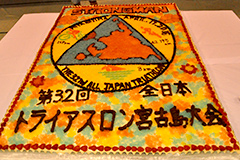
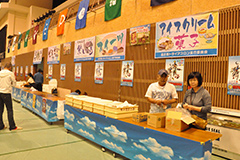
The party also featured such attractions as a traditional Okinawa eisa folk dance and lion dancers, along with an enormous cake. Local restaurants and produce exhibitors welcomed visitors with stalls, providing the Waidoh party with a first-class display of hospitality


